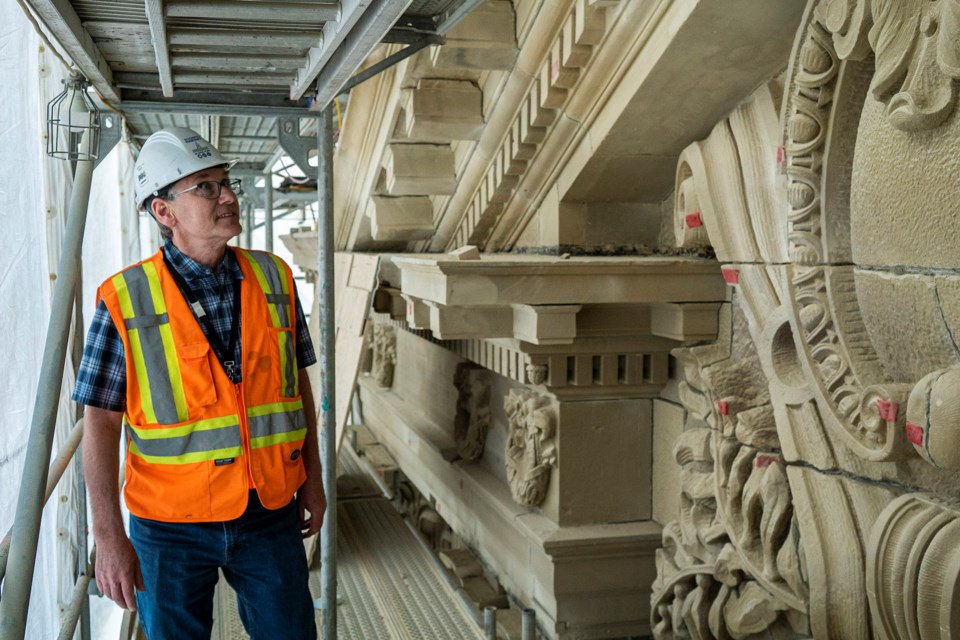Politicians must constantly work on the pillars of democracy, and inside the Alberta Legislature, MLAs are back at work as session resumed last week. Outside, a team of specialists from St. Albert and beyond has the building’s actual pillars in mind – and all of its exterior stonework.
The crown jewel of the province’s architecture is a 107-year-old house made of love, not to mention years of sweat and toil and many tonnes of beautiful sandstone, obviously. From a distance, it looks grand and it’s hard to imagine anything could tarnish its sturdiness and stability.
Up close, there’s a much different picture that comes into focus.
Sandstone, as it turns out, is apt to show its age after it has been exposed to 107 years of Canadian prairie weather. There are cracks and chips – and more – that need to be fixed. Last fall, Building Science Engineering and major contractor Scorpio Masonry began an extensive restoration and repair project of the structure that would likely take three years to complete with an estimated budget of $22.5 million.
Imagine you’ve got a 21,000-piece, three-storey, three-dimensional puzzle – and you have to fix more than 85 per cent of the pieces by removing some and replacing them or working on others where they lie. Technically speaking, they’re called ‘deficiencies’.
Those deficiencies require ‘interventions’ to correct them. That means stonework with new sandstone from the Paskapoo Slopes of southern Alberta, the same place where the original sandstone came from. That heritage connection offers an extra layer of authenticity. Masons from Scorpio cut them off-site with precision down to the millimeter before putting them back into position, sometimes with the assistance of lifts since they can weigh hundreds of kilograms.
For other deficiencies, it means highly specialized repair work and filling in the seams that have opened up from having so much rain drip and snow melt over them.
It also means every little ounce of the crewmembers’ technical training is being put to use, and there’s a lot of pride going into the effort too.
“If you have a client that understands Alberta infrastructure, understands what needs to happen, the heritage that’s on board, and you have good consultants, and good contractors and sub-contractors, and they’re all on the same page, it makes for a successful project. It’s very much a team effort,” stated Kery Donaghey, the district manager of Scorpio Masonry.
“It means more than a job.”
This is what everyone involved considers to be a prestige project, and no one is taking it lightly. Public safety is the number one concern, Donaghey added, but there’s much more at stake than watching out for pieces of stone falling off. The building, in many ways, represents Alberta.
“The longer you leave it, the more the stone deteriorates, which means the more it's going to cost to repair it – and also, worse, the more original stone you're going to lose,” pointed out St. Albert resident Rob Pacholok of Building Science Engineering, looking at some of the work in progress.
Just because a large stone has a small deficiency doesn’t mean that the entire piece has to be replaced.
“We get in here and now we'll save this rather than it completely going. We're going to lose a bit but the rest of the original stone we've saved, whereas if you left the cracks, water would keep going in and it would accelerate the deterioration,” Pacholok added.
“You want to try and preserve as much as possible of the existing structure. That's the heritage approach: as minimal an intervention as possible,” Donaghey said, adding how proud he is to be using Alberta sandstone.
Some of the building’s old windows are being worked on at the same time, though with much different tools and materials. Some of Scorpio’s team members have little putty knives that they are using to repoint some of the mortar. Others have rotary tools like dentists’ drills to make sure that each of the pieces get the custom treatment for fit and style.
The Beaux Arts-style building was designed by Alberta Provincial Architect Allan Merrick Jeffers and architect Richard Blakey. They integrated Greek, Roman and Egyptian influences to suggest the concepts of power, permanence and tradition.
All of those influences are obviously at work on this restoration as well. Building Science Engineering was the prime consultant for the restoration project on the Legislature building’s dome several years ago, as well.
The last time the rest of the exterior received any kind of attention was back in the 1980s, however. This restoration would hopefully last closer to 50 years, Pacholok said with pride.
“It’s a great honour to be a part of this.”




